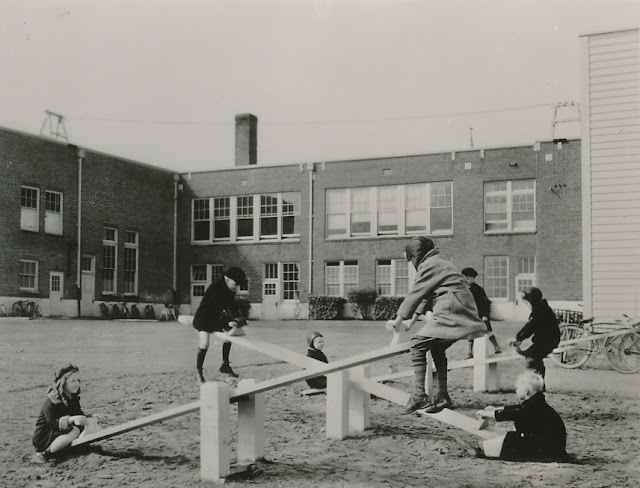New Deal Accomplishment: 39,000 projects to build or improve playgrounds

Above: One of the first New Deal playgrounds, constructed by the Civil Works Administration (CWA), 1933-1934. In his book Spending to Save (1936), Harry Hopkins wrote: "Thanks to CWA... the United States expanded its recreational resources to an unprecedented extent, adding some 200 swimming pools, over 3,700 playgrounds" (p. 122). Photo from: Henry G. Alsberg, America Fights the Depression: A Photographic Record of the Civil Works Administration, New York: Coward-McCann Publishers, 1934, used here for educational and non-commercial purposes.

Above: "City Playground," a lithograph by Harold Anchel (1912-1980), created while he was in the WPA's Federal Art Project, ca. 1938. Across the nation, WPA workers created 3,085 new playgrounds: 1,851 at schools and 1,234 at other locations--and improved another 9,688. Image above from the Baltimore Museum of Art.

Above: The description for this photograph--taken in Bay St. Louis, Mississippi, June 1938--reads, "Hancock County. WPA constructed playground, also run under supervision of WPA." Photo from the National Archives.

Above: The WPA also constructed playground equipment, such as these see-saws at Maple Leaf School in Seattle, Washington. Photo from the National Archives.

Above: Rosedale Playground, Washington, DC, April 1937. This park was renovated by WPA workers, and is being supervised by WPA and NYA (National Youth Administration) recreation leaders. The NYA had perhaps the most extensive playground program, engaging in 17,234 projects to build or improve such facilities. Photo from the National Archives.

Above: This map, from a 1937 WPA report, shows that the WPA's park & playground projects were quite extensive only 14 months into its life (after its May 1935 establishment, the WPA began its work July, 1935).
Above: The Public Works Administration (PWA) also funded playground work, although the full extent of such funding is unclear. Here, we see the PWA-funded Burgwin School (photo and diagram) in Pittsburgh. Accompanying text reads, "In the rear of the school is a playground surfaced in fine red clay and 2 tennis courts with cork asphalt surfaces." Image and text from: C.W. Short and R. Stanley-Brown, Public Buildings: A Survey of Architecture of Projects Constructed by Federal and Other Governmental Bodies Between the Years 1933 and 1939 with the Assistance of the Public Works Administration, Washington, DC: U.S. Government Printing Office, 1939, p. 159.

Above: A playground area was included at Langston Terrace Dwellings, Washington, DC, one of many New Deal housing and community projects. The Langston Terrace Dwellings included animal sculptures created by WPA artists. Photo from the DC Preservation League and the National Park Service.
Playgrounds for millions of children across multiple generations
New Deal playground statistics are a bit hard to compile, due to how they were reported, but here is what we know (or in some cases, don't know):
Civil Works Administration (CWA): 3,700 playgrounds added, as Harry Hopkins worded it (see first photo caption above). Does this mean that all 3,700 were new playgrounds? It seems so, but perhaps he was also including playgrounds that had been abandoned and then restored by CWA.
The Work Division of the Federal Emergency Relief Administration (FERA): 2,382 playgrounds "constructed" and 3,200 "improved" (see reported statistics here). It is also important to remember that some FERA projects were completions of CWA projects, and some FERA projects were completed by WPA.
Works Progress Administration (WPA): 3,085 new playgrounds, and 9,688 projects to add to, reconstruct, or improve existing playgrounds (note: this does not necessarily mean 9,688 separate parks - one might imagine a single park receiving more that one instance of WPA improvement work) (see statistics here).
National Youth Administration (NYA): 4,333 playground projects involving "new construction or additions" and 12,901 playground projects involving "Reconstruction or improvements" (see statistics here). It is important to note that while the NYA was a subdivision of the WPA for the first 4 years of its existence, its work program was not included in the WPA's final report; so, there shouldn't be any co-mingling or double-counting of work accomplishments between these two agencies; thus, we can add them together towards a larger cumulative number of playground projects.
Public Works Administration (PWA), Civilian Conservation Corps (CCC), and other New Deal Programs: The PWA and CCC definitely engaged in some playground construction--the former probably more than the latter, because of its heavy involvement in school construction--but the total numbers are not readily available. The same is true with other New Deal programs, such as the Puerto Rico Reconstruction Administration (PRRA) and various housing programs.
From all of the above, I think we can say with confidence that (1) there were about 39,000 New Deal playground projects, and (2) at least 6,000 of these projects--and potentially much more--involved the creation of a new playground, with the rest being repairs, renovations, additions, improvements, etc. This seems like a shockingly high number, but it must be remembered that the New Deal built or improved tens of thousands of schools across America, and many of its playground projects were probably located at these schools (see the captions for the second image above and the next-to-last image).
In any event, millions of American children, across multiple generations, enjoyed a New Deal for their playgrounds. And this was a great benefit for them. Safely-designed & supervised playgrounds can help children develop their muscles and bones, and can also help them learn how to socially interact with others (see, e.g., "The Benefits of Playground Play for Children," by Emilee Shoemaker, Occupational Therapist, Blanchard Valley Health System (Ohio), accessed July 10, 2025; and "Playgrounds Support Children’s Social-emotional Health," by Catherine Schaefer and Van-Kim Bui Lin, Child Trends, accessed July 10, 2025).




Comments
Post a Comment